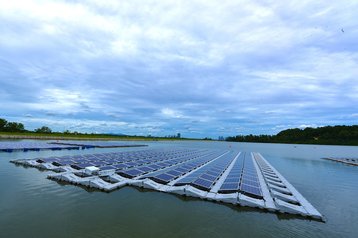Beginning around 2000, big inward investments paved the way for Singapore to become the dominant regional data center hub with a thriving commercial data center sector.
Fast forward to 2019/20 and Singapore is facing significant challenges placing data center operations at the heart of the discussion around sustainability and GDP growth.
For Singapore to meet its climate change commitments without putting the brake on digital economic growth, i3 Solutions Group has some wide-ranging suggestions to align data centers, the digital economy and sustainability.
Singapore tackling climate change
Singapore ratified the Paris Climate Agreement in 2016. Due to geographical constraints, it imports 97.6 percent of its energy. Less than 1 percent comes from renewables (World Bank 2015).
Singapore’s (electrical) energy is generated locally using imported fuels with much coming from low carbon producing natural gas.
With limited space and few energy resources the Singapore Government is working hard on its commitment to the Paris Climate Agreement and its sustainability agenda. Efforts include plans for 1GW solar deployment after 2020 including a floating solar farm of 50MW (peak) at the Tengeh Reservoir. It is also testing one of the world’s largest sea-based offshore floating solar test beds.
January 2019 saw Singapore introduce a carbon tax of $5 per tonne for emitters. This tax is fixed until 2023. By 2030 the cost per tonne is anticipated to increase to between $10 and $15. Singapore’s National Energy Authority says: "Any industrial facility that emits direct greenhouse gas (GHG) equal to or above 2,000 tCO2e annually will be required to be registered as a reportable facility and to submit an Emissions Report annually."
These regulatory and cross-sector moves are welcome. But when it comes to data centers, sector specific radical rethinking is needed to create a sustainable industry that continues to attract investment upon which modern economies depend.
A sustainable sector
There is no escaping the fact that data center operations are energy-intensive and emit CO2.
The question for Singapore, and most metros around the world that have signed the Paris Climate Agreement, is how to meet their commitments while running a productive and sustainable data center sector.
Some cities have opted for a moratorium on building new data centers. Such a move was recently announced by Amsterdam. This is an untenable solution. Such moves will likely scare away developers of efficient facilities to nearby locations considered more data center friendly, and in doing so hamper economic growth.
For countries such as Singapore the solutions need to be long term and highly effective. With scarce land capacity and an energy sector that consequently relies on fuel imports a multi-layered approach is needed to both address the energy needs of new data center developments and the inefficient legacy facilities.
Carbon offsetting through renewables
For new developments a clear opportunity lies in offsetting the carbon footprint of the data center. Any new development drawing power from Singapore’s grid would have its energy use offset through investments by the local provider in environmental projects around the world to balance out their Singapore data center carbon footprint.
This would mean that CO2 reduction projects outside Singapore could offset local CO2 usage.
In PCA terms it is clear that intergovernmental climate negotiations are global and complex. Any proposed changes are subject to ongoing talks which happen mid-year and annually.
As reported recently by the International Energy Authority (IEA) following the 2019 PCA mid-year meeting: “By agreeing to Article 6 of the Paris Agreement, countries opened the way for a new form of international interaction on carbon markets…Article 6.2 sets out the principles for voluntary co-operative approaches. One country can transfer so-called “internationally transferred mitigation outcomes” (ITMOs) to another country, which can then use them towards its NDC (Nationally Determined Contributions) target. These transfers must apply robust and transparent accounting rules to avoid double counting of ITMOs and to ensure environmental integrity. The transfers can take place using various approaches and mechanisms, such as bilateral cooperation programmes between countries, or national or regional emission trading schemes (ETS).”
Clean up or shut down
And what about the existing data centers? Some legacy data centers pre-date Singapore’s data center sustainability standard SS:564 and the Greenmark system. And, many will never achieve their design efficiency for various reasons. The answer surely is regulation to ensure inefficiencies are identified and reported and then improvements made, and the most offending, typically older facilities put on notice to be shut down.
It could be mandated that existing data center operators change their operations with a focus on greater utilisation, higher efficiency, offsetting carbon emissions and modernisation of old facilities. This can be achieved using a mixture of incentives and regulation.
- Data center facilities must be given aggressive targets to lower carbon emissions.
- A tax could be levied on operators of existing data centers to fund oversea carbon offsetting schemes and investments in renewable energy sources.
- Inherently inefficient data centers should be put on notice to either achieve predetermined levels of efficiency, or face being shut down
- Where efficiency targets cannot be meet operators should be mandated to close or replace legacy facilities with new high efficiency data centers.
The solution, not the problem
The problems of addressing sustainability and meeting demand are not unique to Singapore. They are being discussed in cities across the world.
The big picture is addressing the climate crisis. This means investing in renewables, offsetting carbon emissions and creating climate friendly tax environments. Efficient data center operations will have to be mandated if these vital facilities are to become part of the answer to cutting carbon emissions.
For governments, businesses and citizens to benefit from the digital revolution, data center planning and operation needs radical rethinking. Data centers cannot be part of the climate change problem, but rather must evolve and become part of the solution.


